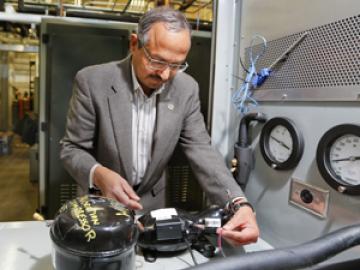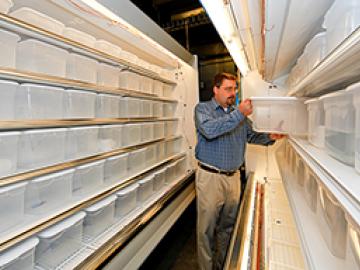
Filter News
Area of Research
- (-) Building Technologies (12)
- (-) Fusion Energy (17)
- (-) Materials for Computing (36)
- (-) National Security (80)
- Advanced Manufacturing (34)
- Biological Systems (18)
- Biology and Environment (177)
- Biology and Soft Matter (5)
- Chemical and Engineering Materials (4)
- Chemistry and Physics at Interfaces (11)
- Clean Energy (522)
- Climate and Environmental Systems (14)
- Computational Biology (6)
- Computational Chemistry (5)
- Computational Engineering (5)
- Computer Science (19)
- Data (1)
- Earth Sciences (1)
- Electricity and Smart Grid (3)
- Energy Frontier Research Centers (14)
- Energy Sciences (5)
- Fossil Energy (3)
- Fuel Cycle Science and Technology (3)
- Functional Materials for Energy (16)
- Fusion and Fission (54)
- Geographic Information Science and Technology (3)
- Isotope Development and Production (3)
- Isotopes (35)
- Materials (433)
- Materials Characterization (2)
- Materials Synthesis from Atoms to Systems (13)
- Materials Under Extremes (12)
- Mathematics (1)
- Neutron Data Analysis and Visualization (4)
- Neutron Science (190)
- Nuclear Science and Technology (74)
- Nuclear Systems Modeling, Simulation and Validation (3)
- Nuclear Systems Technology (1)
- Quantum Condensed Matter (4)
- Quantum information Science (9)
- Reactor Technology (1)
- Renewable Energy (4)
- Sensors and Controls (5)
- Supercomputing (311)
- Transportation Systems (11)
News Type
News Topics
- 3-D Printing/Advanced Manufacturing (8)
- Advanced Reactors (8)
- Artificial Intelligence (12)
- Big Data (6)
- Bioenergy (3)
- Biology (5)
- Biomedical (4)
- Biotechnology (1)
- Buildings (4)
- Chemical Sciences (6)
- Climate Change (5)
- Composites (1)
- Computer Science (28)
- Coronavirus (5)
- Cybersecurity (19)
- Decarbonization (2)
- Energy Storage (6)
- Environment (6)
- Exascale Computing (1)
- Frontier (2)
- Fusion (14)
- Grid (6)
- High-Performance Computing (4)
- Isotopes (1)
- Machine Learning (12)
- Materials (13)
- Materials Science (20)
- Microscopy (4)
- Nanotechnology (8)
- National Security (35)
- Neutron Science (9)
- Nuclear Energy (15)
- Partnerships (5)
- Physics (1)
- Polymers (6)
- Quantum Computing (1)
- Quantum Science (4)
- Security (12)
- Simulation (1)
- Space Exploration (1)
- Summit (4)
- Sustainable Energy (11)
- Transportation (7)
Media Contacts


A research demonstration unveiled today at the Department of Energy’s Oak Ridge National Laboratory combines clean energy technologies into a 3D-printed building and vehicle to showcase a new approach to energy use, storage and consumption. The Additive Manufactur...

When it’s up and running, the ITER fusion reactor will be very big and very hot, with more than 800 cubic meters of hydrogen plasma reaching 170 million degrees centigrade. The systems that fuel and control it, on the other hand, will be small and very cold. Pellets of frozen gas will be shot int...

The Department of Energy’s Oak Ridge National Laboratory and Whirlpool Corporation are collaborating to design a refrigerator that could cut energy use by up to 40 percent compared with current models






The American Conference on Neutron Scattering returned to Knoxville this week, 12 years after its inaugural meeting there in 2002.


